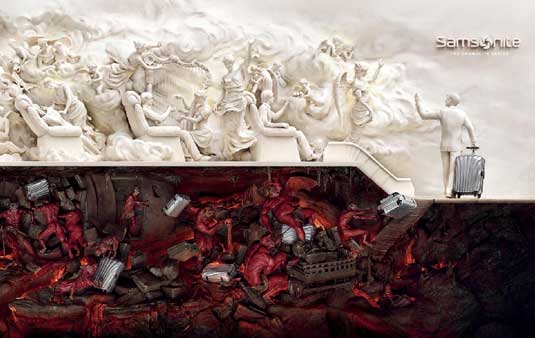Ogilvy's Graham Fink on China's advertising revolution
Graham Fink, chief creative officer at Ogilvy in Shanghai, explains why the design scene in China is finally starting to compete on the global stage.
Having been in China for exactly two years now, I've seen huge changes. Shanghai looks very different now to how it did when I first arrived. The pace here is so much faster than the UK, and it’s an incredibly exciting city to live in.
Just as everything moves along quickly here, the design scene is shifting, too. This year, the Cannes Lions festival hosted its first ever China Day, attended by clients, creatives and even government ministers. That has to be a good thing - it means creativity is high on the agenda, and now it needs to be more prevalent in the work Chinese studios are producing.
Emerging industry
One of the things that's often overlooked is that China has only been doing advertising, as the West understands it, for around 20 years. Clients and consumers are less sophisticated in their tastes and therefore most of the work here is quite rational and straightforward.
Sit and watch the commercial breaks on TV and you'll see happy families, blue skies, white fluffy clouds, green grass, perfect lighting, smiling faces and flawless skin, all accompanied by a deluge of information and cutesy music. The car adverts are particularly uninspiring - I would defy anyone to be able to tell them apart.
People power
How gratifying and encouraging then, when one or two clients have listened to their ad agencies and done something different. DDB recently did a campaign for VW where it asked the public to design 'The people's car'. The result was not only a breakthrough, but has become something that China can hold up to the world and be proud.

Similarly with JWT Shanghai's brilliant Samsonite poster that won a Grand Prix in Cannes in 2011. The three-act design showing the plane journey of a man and his luggage is highly original in any country, not least China. Not to be outdone, Ogilvy & Mather China won the Grand Prix the following year with #CokeHands, which has since gone on to become the most awarded ad in Coca-Cola's history.
It was encouraging to note that work from China won 25 Lions this year, an all-time high. Great creative work helps attract overseas talent too, and I get a lot of calls not just from the UK but from places as diverse as Brazil, USA, Argentina, Sweden and of course around Asia. So it's a very exciting time to be here and I can honestly say that in my opinion there are currently more creative opportunities than in London.
Daily design news, reviews, how-tos and more, as picked by the editors.
Local knowledge
The hard thing, though, is to get the balance right between locals and expats. Although in Shanghai, speaking Mandarin is not essential, you do need to have some knowledge of the country. Obviously this can take time to acquire, especially as the place is so big.
There are actually more people in Shanghai than there are in the whole of Australia, and according to Millward Brown there is only a 52 per cent chance that what works in one Chinese province will work in another. With 34 provinces or divisions to create work for, things can get a little frustrating at times.
Another thing that I find fascinating is the cultural tapestry woven together here. Although the majority of people at my studio are mainland Chinese, we have people from all over Asia, as well as a smattering of Aussies, Americans and Brits. People come from very different backgrounds and educational systems and of course there are a lot of different opinions, which makes the meetings so much more interesting.
Illusion of agreement
However, there can be issues with this. I’m painting everyone with a rather large ink brush here, but the general rule is that Asians, especially the Chinese, are very humble and quite shy. No one ever asks questions. So they may well seem to agree in the meeting, but 30 mins later on Weibo (Chinese Twitter), the truth will out.
It's one of the more difficult tasks in the creative department, because I really want to encourage everyone to have a voice, I want to know what they think and, perhaps more importantly, what they feel.
Copyist culture
One thing that I've noticed is how in an attempt to catch up with the West, the default practice is to copy it. The philosophy seems to be, "Well we know what they do is great, we are not yet capable, so let’s learn by copying." Sure, creativity is supposed to be all about originality, but let me point out that the great artists learnt their trade by copying the masters. So having pondered this state of affairs for a while, I now have a more understanding view.
One thing that does suffer though is that by focusing on copying the West, perhaps creatives in China are missing what is right under their noses. Creativity is all around in abundance, it's just that the jewels need cutting from the stones. Hundreds of years ago it was China that lead the way in terms of innovation. It is my quest to help bring this back.
Words: Graham Fink
Graham Fink is chief creative officer at Ogilvy & Mather China, and in his first year at the company won a Cannes Grand Prix for his #CokeHands campaign. His 25-year career also includes a stint at M&C Saatchi.
This article originally appeared in Computer Arts issue 218.
Liked this? Read these!
- Brilliant examles of billboard advertising
- Check out these top TV commercials
- The designer's guide to the Golden Ratio
Is China's design scene on the rise? Tell us in the comments!

The Creative Bloq team is made up of a group of art and design enthusiasts, and has changed and evolved since Creative Bloq began back in 2012. The current website team consists of eight full-time members of staff: Editor Georgia Coggan, Deputy Editor Rosie Hilder, Ecommerce Editor Beren Neale, Senior News Editor Daniel Piper, Editor, Digital Art and 3D Ian Dean, Tech Reviews Editor Erlingur Einarsson, Ecommerce Writer Beth Nicholls and Staff Writer Natalie Fear, as well as a roster of freelancers from around the world. The ImagineFX magazine team also pitch in, ensuring that content from leading digital art publication ImagineFX is represented on Creative Bloq.
